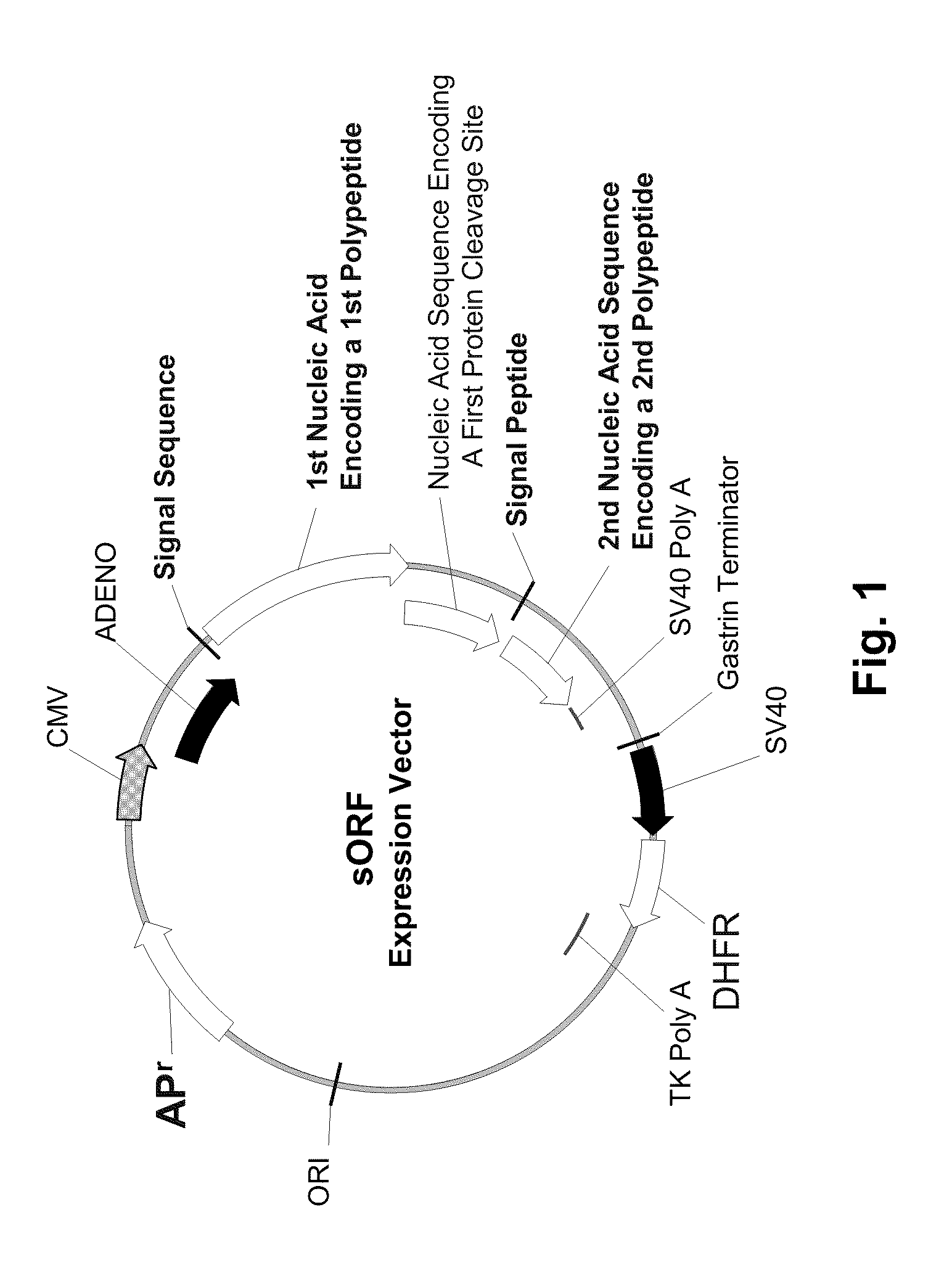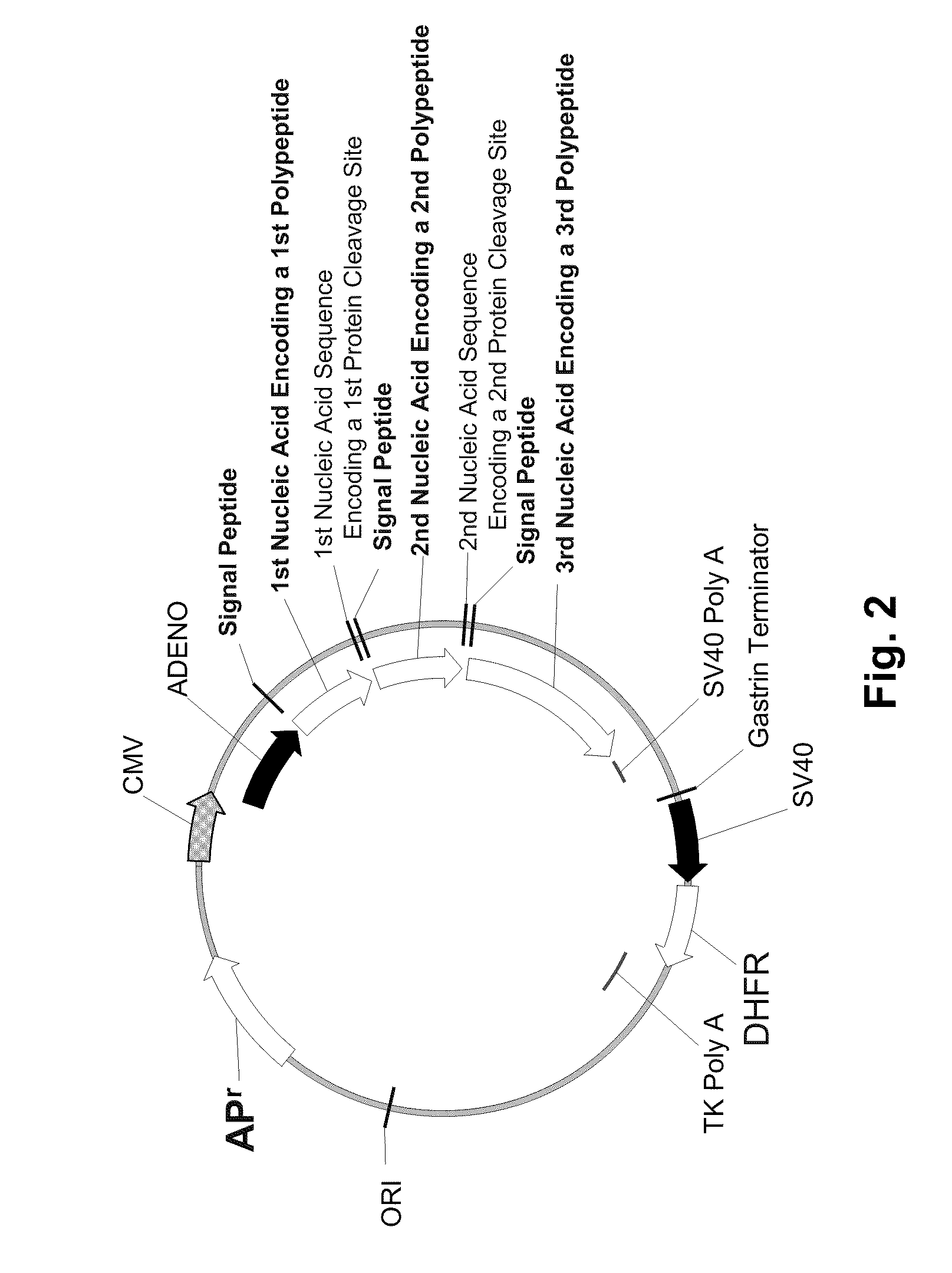Multiple Gene Expression Including sORF Constructs and Methods with Polyproteins, Pro-Proteins and Proteolysis
a technology of sorf and constructs, applied in the field of molecular biology, can solve the problems of significant cost associated with sufficient production, the subtle changes necessary to make an engineered product efficient and practical, and the dissimilarity of the expression of heavy and light levels
- Summary
- Abstract
- Description
- Claims
- Application Information
AI Technical Summary
Benefits of technology
Problems solved by technology
Method used
Image
Examples
example 1
Expression of Immunoglobulins with Intein-Mediated Processing
[0357]A strategy for the efficient expression of antibody molecules is via polyprotein expression, wherein an intein is located between the heavy and light chains, with modification of the intein sequence and / or junction sequences such that there is release of the component proteins without ligation of the N-terminal and C-terminal proteins. Within such constructs, there can be one copy of each of the relevant heavy and light chains, or the light chain can be duplicated, or there can be multiple copies of both heavy and light chains, provided that functional cleavage sequence is provided to promote separation of each immunoglobulin-derived protein within the polyprotein. The intein strategy can be employed more than once or a different proteolytic processing sequence or enzyme can be positioned at at least one terminus of an immunoglobulin derived protein.
[0358]The intein from Pyrococcus horikoshii has been incorporated in...
example 2
Construction of Immunoglobulin Polyprotein Sequences and Vectors with Drosophila melanogaster Hedgehog Auto Processing Domain, C17 and C25 Sequences
[0401]A further strategy for the efficient expression of antibody molecules is polyprotein expression, wherein an Hedgehog domain is located between the heavy and light chains, with modification of the Hedgehog domain sequence and / or junction sequences such that there is release of the component proteins without cholesterol addition to the N-terminal protein. Within such constructs, there can be one copy of each of the relevant heavy and light chains, or the light chain can be duplicated to provide at least two light chains, or there can be multiple copies of both heavy and light chains, provided that a functional cleavage sequence is provided to promote separation of each immunoglobulin-derived protein within the polyprotein. A particular cleavage site strategy (e.g., the Hedgehog domain) can be employed more than once, or for multiple ...
example 3
Antibody Expression with TEV Recognition Sequence for Proteolytic Processing
[0412]Constructs and expression vectors are generated to direct the expression of antibodies specific for tumor necrosis factor-α, interleukin-12, interleukin-18 and erythropoietin receptor, with a TEV recognition sequence between the immunoglobulin heavy and light chain sequence segments that comprise the antibody of interest. Preferably, constructs include expression vectors comprising an adenovirus major late promoter and cytomegalovirus enhancer directing transcription of the antibody heavy chain of interest which is preceeded by an in-frame leader sequence. The heavy chain coding sequence is linked to an in-frame furin cleavage site and a TEV recognition sequence (E-P-V-Y-F-Q-G) followed by the coding region for the nuclear-localization-region-deleted TEV protease (Ceriani et al. (1998) Plant Molec Biol. 36:239), followed by a second TEV recognition sequence. The second TEV recognition sequence is linke...
PUM
| Property | Measurement | Unit |
|---|---|---|
| nucleic acid | aaaaa | aaaaa |
| nucleic acid sequence | aaaaa | aaaaa |
Abstract
Description
Claims
Application Information
 Login to View More
Login to View More - R&D
- Intellectual Property
- Life Sciences
- Materials
- Tech Scout
- Unparalleled Data Quality
- Higher Quality Content
- 60% Fewer Hallucinations
Browse by: Latest US Patents, China's latest patents, Technical Efficacy Thesaurus, Application Domain, Technology Topic, Popular Technical Reports.
© 2025 PatSnap. All rights reserved.Legal|Privacy policy|Modern Slavery Act Transparency Statement|Sitemap|About US| Contact US: help@patsnap.com



